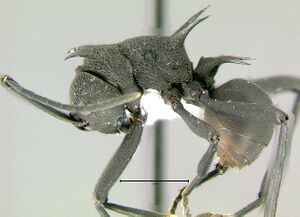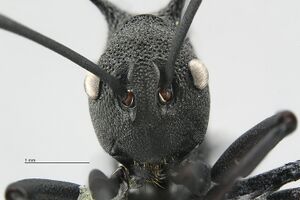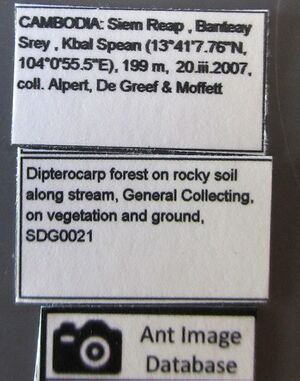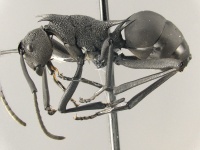Polyrhachis armata
| Polyrhachis armata | |
|---|---|

| |
| Scientific classification | |
| Kingdom: | Animalia |
| Phylum: | Arthropoda |
| Class: | Insecta |
| Order: | Hymenoptera |
| Family: | Formicidae |
| Subfamily: | Formicinae |
| Tribe: | Camponotini |
| Genus: | Polyrhachis |
| Subgenus: | Myrmhopla |
| Species: | P. armata |
| Binomial name | |
| Polyrhachis armata (Le Guillou, 1842) | |
| Subspecies | |
| |
| Synonyms | |
| |
Polyrhachis armata is a very widespread and distinctive south-east Asian species of the subgenus Myrmhopla. Heterick & Kitching (2022) collected this species in the canopy of a lowland dipterocarp forest in Brunei.
Identification
A member of the Polyrhachis armata species group.
Keys including this Species
- Key to Sulawesi Polyrhachis subgenera and species-groups
- Key to Polyrhachis armata-group species
- Key to Polyrhachis of India
Distribution
Kohout (2008) - A relatively common species that extends from the Andaman Islands and Indo-China, including Myanmar, Peninsular Malaysia, Singapore, Thailand and Vietnam, eastwards to the Philippines and south to Borneo, Sumatra and Java. It was listed from Sulawesi by Emery (1901), however, I have not seen any specimens originating from east of Wallace’s line.
Latitudinal Distribution Pattern
Latitudinal Range: 21.96608333° to -7.5°.
| North Temperate |
North Subtropical |
Tropical | South Subtropical |
South Temperate |
- Source: AntMaps
Distribution based on Regional Taxon Lists
Indo-Australian Region: Borneo, Brunei Darussalam, Indonesia, Malaysia, Philippines (type locality), Singapore.
Oriental Region: Cambodia, India, Laos, Thailand.
Palaearctic Region: China.
Distribution based on AntMaps
Distribution based on AntWeb specimens
Check data from AntWeb
Countries Occupied
| Number of countries occupied by this species based on AntWiki Regional Taxon Lists. In general, fewer countries occupied indicates a narrower range, while more countries indicates a more widespread species. |

|
Estimated Abundance
| Relative abundance based on number of AntMaps records per species (this species within the purple bar). Fewer records (to the left) indicates a less abundant/encountered species while more records (to the right) indicates more abundant/encountered species. |

|
Biology
Association with Other Organisms
 Explore: Show all Associate data or Search these data. See also a list of all data tables or learn how data is managed.
Explore: Show all Associate data or Search these data. See also a list of all data tables or learn how data is managed.
- This species is a host for the fungus Ophiocordyceps formicarum (a parasitoid) (Quevillon, 2018) (encounter mode primary; direct transmission; transmission outside nest).
- This species is a host for the fungus Ophiocordyceps irangiensis (a parasitoid) (Quevillon, 2018) (encounter mode primary; direct transmission; transmission outside nest).
- This species is a host for the fungus Ophiocordyceps myrmecophila (a parasitoid) (Quevillon, 2018) (encounter mode primary; direct transmission; transmission outside nest).
- This species is a host for the fungus Ophiocordyceps unilateralis (a parasitoid) (Quevillon, 2018) (encounter mode primary; direct transmission; transmission outside nest).
- This species is a host for the fungus Ophiocordyceps unilateralis (a pathogen) (Shrestha et al., 2017).
Castes
Worker
   
| |
| . | Owned by Museum of Comparative Zoology. |
   
| |
| . | Owned by Museum of Comparative Zoology. |
Nomenclature
The following information is derived from Barry Bolton's Online Catalogue of the Ants of the World.
- armata. Formica armata Le Guillou, 1842: 313 (q.) PHILIPPINES. Mayr, 1867a: 46 (w.); Karavaiev, 1927e: 29 (m.); Wheeler, G.C. & Wheeler, J. 1990b: 759 (l.). Combination in Polyrhachis: Roger, 1863b: 9; in P. (Myrmhopla): Forel, 1915b: 107. Senior synonym of pandarus: Roger, 1863b: 9. Current subspecies: nominal plus defensa. See also: Bingham, 1903: 393.
- pandarus. Polyrhachis pandarus Smith, F. 1857a: 62 (w.) BORNEO. Mayr, 1862: 679 (q.). Junior synonym of armata: Roger, 1863b: 9.
Unless otherwise noted the text for the remainder of this section is reported from the publication that includes the original description.
Kohout (2007) - Polyrhachis armata was originally described from the Philippines but the type material has apparently been lost. Consequently I have compared the holotype of Polyrhachis maryatiae with the available syntypes of Polyrhachis pandarus Fr. Smith and Polyrhachis armata defensa Fr. Smith (BMNH and OXUM respectively). Both species were considered by Roger (1863), Dalla Torre (1893) and Wheeler (1919) to be junior synonyms of P. armata . However, P. defensa was later revived from synonymy by Emery (1925) and considered by him and subsequent authors, including Bolton (1995) and Dorow (1995), to be a subspecies of P. armata. This decision was presumably based on variation in the colour of the gaster which is black in the nominate subspecies and reddish-brown in defensa. I strongly suspect that the subspecific status of defensa is unwarranted but am reluctant to formalise the synonymy before a more detailed examination of the variation of P. armata across its entire geographic range.
Description
Type Material
Kohout (2008) - Holotype queen. PHILIPPINES, MINDANAO, Zamboanga, ?Musee National d'Histoire Naturelle (type presumed lost).
References
- Ariani, L., Yulminarti, Herwina, H., Janra, M.N., Satria, R. 2021. Ant community (Hymenoptera: Formicidae) at Ghimbo Potai Traditional Prohibited Forest, Kampar, Riau. IOP Conference Series: Earth and Environmental Science 757, 012080 (doi:10.1088/1755-1315/757/1/012080).
- Baltazar, C.R. 1966. A catalogue of Philippine Hymenoptera (with a bibliography, 1758-1963). Pacific Insects Monographs 8: 1-488. (page 281, listed)
- Bingham, C. T. 1903. The fauna of British India, including Ceylon and Burma. Hymenoptera, Vol. II. Ants and Cuckoo-wasps. London: Taylor and Francis, 506 pp. (page 393, see also)
- Blanchard, B.D., Nakamura, A., Cao, M., Chen, S.T., Moreau, C.S. 2020. Spine and dine: A key defensive trait promotes ecological success in spiny ants. Ecology and Evolution 10, 5852–5863 (doi:10.1002/ECE3.6322).
- Forel, A. 1915b. Results of Dr. E. Mjöbergs Swedish Scientific Expeditions to Australia 1910-13. 2. Ameisen. Ark. Zool. 9(1 16: 1-119 (page 107, Combination in P. (Myrmhopla))
- General, D.E.M. 2021. A preliminary checklist of the ants (Hymenoptera: Formicidae) of the Mt. Pantaron Range, Bukidnon Province, Mindanao Island, Philippines. Halteres, 12:4-14 (doi:10.5281/ZENODO.5371745).
- Heterick, B.E., Kitching, R.L. 2022. The ants (Hymenoptera: Formicidae) of a one-hectare plot of lowland dipterocarp forest. Entomologist’s Monthly Magazine 158(4), 261–272 (doi:10.31184/m00138908.1584.4153).
- Hughes, D.P., Araújo, J.P.M., Loreto, R.G., Quevillon, L., de Bekker, C., Evans, H.C. 2016. From so simple a beginning. In: Advances in Genetics. Elsevier BV (doi:10.1016/bs.adgen.2016.01.004).
- Karavaiev, V. 1927f. Ameisen aus dem Indo-Australischen Gebiet. III. Zb. Prats Zool. Muz. 3:3-52 [= Tr. Ukr. Akad. Nauk Fiz.-Mat. Vidd. 7:3-52]. (page 29, male described)
- Khachonpisitsak, S., Yamane, S., Sriwichai, P., Jaitrong, W. 2020. An updated checklist of the ants of Thailand (Hymenoptera, Formicidae). ZooKeys 998, 1–182 (doi:10.3897/zookeys.998.54902).
- Kohout, R.J. 2007. Polyrhachis (Myrmhopla) maryatiae, a new species of the armata group from Borneo (Hymenoptera: Formicidae, Formicinae). Asian Myrmecology, 1, 1–5.
- Kohout, R.J. 2008a. A review of the Polyrhachis ants of Sulawesi with keys and descriptions of new species (Hymenoptera: Formicidae: Formicinae). Memoirs of the Queensland Museum. 52:255-317.
- Kreider, J.J., Chen, T.W., Hartke, T.R., Buchori, D., Hidayat, P., Nazarreta, R., Scheu, S., Drescher, J. 2021. Rainforest conversion to monocultures favors generalist ants with large colonies. Ecosphere 12 (doi:10.1002/ecs2.3717).
- Le Guillou, E. J. F. 1842 [1841]. Catalogue raisonné des insectes hyménoptères recueillis dans le voyage de circumnavigation des corvettes l'Astrolabe et la Zélée. Ann. Soc. Entomol. Fr. 10: 311-324. (page 313, queen described)
- Liu, C., Fischer, G., Hita Garcia, F., Yamane, S., Liu, Q., Peng, Y.Q., Economo, E.P., Guénard, B., Pierce, N.E. 2020. Ants of the Hengduan Mountains: a new altitudinal survey and updated checklist for Yunnan Province highlight an understudied insect biodiversity hotspot. ZooKeys 978, 1–171 (doi:10.3897/zookeys.978.55767).
- Mayr, G. 1867a. Adnotationes in monographiam formicidarum Indo-Neerlandicarum. Tijdschr. Entomol. 10: 33-117 (page 46, worker described)
- Roger, J. 1863b. Verzeichniss der Formiciden-Gattungen und Arten. Berl. Entomol. Z. 7(B Beilage: 1-65 (page 9, Combination in Polyrhachis)
- Roger, J. 1863b. Verzeichniss der Formiciden-Gattungen und Arten. Berl. Entomol. Z. 7(B Beilage: 1-65 (page 9, Senior synonym of pandarus)
- Shrestha B, Tanaka E, Hyun MW, Han JG, Kim CS, Jo JW, Han SK, Oh J, Sung JM, Sung GH. 2017. Mycosphere Essay 19. Cordyceps species parasitizing hymenopteran and hemipteran insects. Mycosphere 8(9): 1424–1442 (DOI 10.5943/mycosphere/8/9/8).
- Wang, W.Y., Soh, E.J.Y., Yong, G.W.J., Wong, M.K.L., Benoit Guénard, Economo, E.P., Yamane, S. 2022. Remarkable diversity in a little red dot: a comprehensive checklist of known ant species in Singapore (Hymenoptera: Formicidae) with notes on ecology and taxonomy. Asian Myrmecology 15: e015006 (doi:10.20362/am.015006).
- Wheeler, G. C.; Wheeler, J. 1990b. Larvae of the formicine ant genus Polyrhachis. Trans. Am. Entomol. Soc. 116: 753-767 (page 759, larva described)
- Wong, T.L., Guénard, B. 2020. Review of ants from the genus Polyrhachis Smith (Hymenoptera: Formicidae: Formicinae) in Hong Kong and Macau, with notes on their natural history. Asian Myrmecology 13: e013001 (doi:10.20362/am.013001).
- Yamane, S., Tanaka, H.O., Hasimoto, Y., Ohashi, M., Meleng, P., Itioka, T. 2021. A list of ants from Lambir Hills National Park and its vicinity, with their biological information: Part II. Subfamilies Leptanillinae, Proceratiinae, Amblyoponinae, Ponerinae, Dorylinae, Dolichoderinae, Ectatomminae and Formicinae. Contributions from the Biological Laboratory, Kyoto University 31, 87–157.
- Zettel, H. 2019. Two new species from Malaysia and further taxonomic notes on Polyrhachis s.str. (Hymenoptera: Formicidae). Zeitschrift der Arbeitsgemeinschaft Österreichischer Entomologen 71: 57-73.
References based on Global Ant Biodiversity Informatics
- Alcantara M. J., S. Modi, T. C. Ling, J. Monkai, H. Xu, S. Huang, and A. Nakamura. 2019. Differences in geographic distribution of ant species (Hymenoptera: Formicidae) between forests and rubber plantations: a case study in Xishuangbanna, China, and a global meta-analysis. Myrmecological News 29: 135-145.
- Ashmead W. H. 1904. A list of the Hymenoptera of the Philippine Islands, with descriptions of new species. J. N. Y. Entomol. Soc. 12:1-22.
- Chantarasawat N., D. Sitthicharoenchai, C. Chaisuekul, and C. Lekprayoon. 2013. Comparison of Ants (Hymenoptera: Formicidae) Diversity in Dry Dipterocarp and Mixed-Deciduous Forests at Sri Nan National Park, Northern Thailand. Tropical Natural History 13(1): 1-19.
- Chapman J. W. 1965. Studies on the ecology of the army ants of the Philippines genus Aenictus Schuckard (Hymenoptera: Formicidae). Philippine Journal of Science. 93: 551-595.
- Chapman, J. W., and Capco, S. R. 1951. Check list of the ants (Hymenoptera: Formicidae) of Asia. Monogr. Inst. Sci. Technol. Manila 1: 1-327
- Chhotani O. B., and P. K. Maiti. 1977. Contribution to the knowledge of Formicidae of the Andaman Islands. Zoological Survey of India 3(1): 17-20.
- Chung A.Y.C., and M. Mohamed. 1996. A comparative study of the ant fauna in a primary and secondary forest in Sabah, Malaysia. In Edwards, D.S. Booth, W.E. and S.C. Choy (eds). Tropical Rainforest Research. Kluwer Academic Publishers. Pp 357-366.
- Davidson D. W., S. C. Cook, R. R. Snelling and T. H. Chua. 2003. Explaining the Abundance of Ants in Lowland Tropical Rainforest Canopies. Science 300: 969-972.
- Dorow W. H. O., and U. Maschwitz. 1990. The arachne-group of Polyrhachis (Formicidae: Formicinae): weaver ants cultivating Homoptera on bamboo. Insectes Sociaux. 37: 73-89.
- Emery C. 1887. Catalogo delle formiche esistenti nelle collezioni del Museo Civico di Genova. Parte terza. Formiche della regione Indo-Malese e dell'Australia. [part]. Ann. Mus. Civ. Stor. Nat. 24(4): 209-258.
- Emery C. 1888. Catalogo delle formiche esistenti nelle collezioni del Museo Civico di Genova. Parte terza . Formiche raccolte dal sig. Elio Modigliani in Sumatra e nell'isola Nias. Annali del Museo Civico di Storia Naturale 25: 528-534.
- Emery C. 1901. Formiciden von Celebes. Zoologische Jahrbücher. Abteilung für Systematik, Geographie und Biologie der Tiere 14:565-580.
- Emery, C. "Catalogo delle formiche esistenti nelle collezioni del Museo Civico di Genova. Parte terza. Formiche della regione Indo-Malese e dell'Australia." Annali del Museo Civico di Storia Naturale Giacomo Doria (Genova) (2) 4, no. 24 (1887): 209-258.
- Emery, C. "Formiche raccolte da Elio Modigliani in Sumatra, Engano e Mentawei." Annali del Museo Civico di Storia Naturale Giacomo Doria (Genova) (2) 20, no. 40 (1900): 661-722.
- Floren A., W. Wetzel, and M. Staab. 2013. The contribution of canopy species to overall ant diversity (Hymenoptera: Formicidae) in temperate and tropical ecosystems. Myrmecological News 19: 65-74.
- Fontanilla A. M., A. Nakamura, Z. Xu, M. Cao, R. L. Kitching, Y. Tang, and C. J. Burwell. 2019. Taxonomic and functional ant diversity along tropical, subtropical, and subalpine elevational transects in southwest China. Insects 10, 128; doi:10.3390/insects10050128
- Forel A. 1886. Études myrmécologiques en 1886. Annales de la Société Entomologique de Belgique. 30: 131-215.
- Forel A. 1893. Les Formicides de l'Empire des Indes et de Ceylan. Part III. J. Bombay Nat. Hist. Soc. 8: 17-36.
- Forel A. 1904. Note sur les fourmis du Musée Zoologique de l'Académie Impériale des Sciences à St. Pétersbourg. Ezheg. Zool. Muz. 8: 368-388.
- Forel A. 1909. Ameisen aus Java und Krakatau beobachtet und gesammelt von Herrn Edward Jacobson. Notes Leyden Mus. 31: 221-232.
- Forel A. 1911. Fourmis de Bornéo, Singapore, Ceylan, etc. récoltées par MM. Haviland, Green, Winkler, Will, Hose, Roepke et Waldo. Rev. Suisse Zool. 19: 23-62.
- Forel A. 1912. Einige neue und interessante Ameisenformen aus Sumatra etc. Zool. Jahrb. Suppl. 15: 51-78.
- Forel A. 1913k. Wissenschaftliche Ergebnisse einer Forschungsreise nach Ostindien ausgeführt im Auftrage der Kgl. Preuss. Akademie der Wissenschaften zu Berlin von H. v. Buttel-Reepen. II. Ameisen aus Sumatra, Java, Malacca und Ceylon. Gesammelt von Herrn Prof. Dr. v. Buttel-Reepen in den Jahren 1911-1912. Zoologische Jahrbücher. Abteilung für Systematik, Geographie und Biologie der Tiere 36:1-148.
- Ghosh S. N., S. Sheela, B. G. Kundu, S. Roychowdhury, and R. N. Tiwari. 2006. Insecta: Hymenoptera: Formicidae. Pp. 369-398 in: Alfred, J. R. B. (ed.) 2006. Fauna of Arunachal Pradesh. (Part -2). [State Fauna Series 13.]. New Delhi: Zoological Survey of India, iv + 518 pp.
- Guénard B., and R. R. Dunn. 2012. A checklist of the ants of China. Zootaxa 3558: 1-77.
- Hannan M.A. 2003. Ants of Bangladesh. ANeT Newsletter 6: 10-14.
- Hashimoto Y., Y. Morimoto, E. S. Widodo, and M. Mohamed. 2006. Vertical distribution pattern of ants in a Bornean tropical rainforest (Hymenoptera: Formicidae). Sociobiology 47(3): 697- 710.
- IZIKO South Africa Museum Collection
- Itino T., and S. Yamane. The vertical distribution of ants on canopy trees in a Bornean lowland rainf forest. Tropics 4(2/3): 277-281.
- Ito, F.; Yamane, S.; Eguchi, K.; Noerdjito, W. A.; Kahono, S.; Tsuji, K.; Ohkawara, K.; Yamauchi, K.; Nishida, T.; Nakamura, K. 2001. Ant species diversity in the Bogor Botanic Garden, West Java, Indonesia, with descriptions of two new species of the genus Leptanilla (Hymenoptera, Formicidae). Tropics 10:379-404.
- Jaitrong W., B. Guenard, E. P. Economo, N. Buddhakala, and S. Yamane. 2016. A checklist of known ant species of Laos (Hymenoptera: Formicidae). Asian Myrmecology 8: 1-32. DOI: 10.20362/am.008019
- Jaitrong W., and T. Ting-Nga. 2005. Ant fauna of Peninsular Botanical Garden (Khao Chong), Trang Province, Southern Thailand (Hymenoptera: Formicidae). The Thailand Natural History Museum Journal 1(2): 137-147.
- Jaitrong W.; Nabhitabhata, J. 2005. A list of known ant species of Thailand. The Thailand Natural History Museum Journal 1(1): 9-54.
- Karavaiev V. 1914. Eine neue Weberameise, Polyrhachis armata le Guillou. Biol. Centralbl. 34: 440-444.
- Kohout R.J., and M. Mohamed. 2008. A preliminary list of the Polyrhachis ants of the Maliau Basin Conservation area in Sabah, Borneo (Hymenoptera: Formicidae: Formicinae). Asian Myrmecology 2: 63-70.
- Kohout, R.J. 2007. Polyrhachis (Myrmhopla) maryatiae, a new species of the armatagroup from Borneo (Hymenoptera: Formicidae, Formicinae). Asian Myrmecology 1:1-5
- Li Q., Y. Chen, S. Wang, Y. Zheng, Y. Zhu, and S. Wang. 2009. Diversity of ants in subtropical evergreen broadleaved forest in Pu'er City, Yunnan. Biodiversity Science 17(3): 233-239.
- Li Z.h. 2006. List of Chinese Insects. Volume 4. Sun Yat-sen University Press
- Majer J. D., R. L. Kitching, B. E. Heterick, K. Hurley, and K. E. C. Brennan. 2001. North-south patterns within arboreal ant assembalages from rain forests in Eastern Australia. Biotropica 33(4): 643-661.
- Mathew R. 2003. On Formicidae (Insecta: Hymenoptera) of Nongkhyllem Wild Life Sanctuary, Ri-Bhoi District, Meghalaya. Records of the Zoological Survey of India 101:195-207.
- Mathew R., and R. N. Tiwari. 2000. Insecta: Hymenoptera: Formicidae. Pp. 251-409 in: Director; Zoological Survey of India (ed.) 2000. Fauna of of Meghalaya. Part 7. [State Fauna Series 4.] Insecta 2000. Calcutta: Zoological Survey of India, 621 pp.
- Mohamed M. 1995. A preliminary list of ants (Hymenoptera: Formicidae) of the Tawau Hills Park, Sabah. In: Ghazally Ismail et al. (eds.), Tawau Hills Park, Sabah, Pelanduk Pub. Pp. 205-213.
- Mohanraj P., M. Ali, and K. Veerakumari. 2010. Formicidae of the Andaman and Nicobar Islands (Indian Ocean: Bay of Bengal). Journal of Insect Science 10: Article 172
- Mohanraj, P., M. Ali and K. Veenakumari. 2010. Formicidae of the Andaman and Nicobar Islands (Indian Ocean: Bay Of Bengal). Journal of Insect Science 10:172.
- Pfeiffer M.; Mezger, D.; Hosoishi, S.; Bakhtiar, E. Y.; Kohout, R. J. 2011. The Formicidae of Borneo (Insecta: Hymenoptera): a preliminary species list. Asian Myrmecology 4:9-58
- Philpott S.M., P. Bichier, R.A. Rice, and R. Greenberg. 2008. Biodiversity conservation, yield, and alternative products in coffee agroecosystems in Sumatra, Indonesia. Biodivers. Conserv. 17: 1805-1820. Data obtained from Stacy Philpott
- Ran H., and S. Y. Zhou. 2013. Checklist of Chinese Ants: Formicomorph Subfamilies ( Hymenoptera: Formicidae) (III). Journal of Guangxi Normal University : Natural Science Edition 31(1): 104-111.
- Robson Simon Ant Collection, 05-Sept-2014
- Robson Simon Database Polyrhachis -05 Sept 2014
- Santschi F. 1928. Fourmis de Sumatra, récoltées par Mr. J. B. Corporaal. Tijdschrift voor Entomologie 71: 119-140.
- Sitthicharoenchai D., and N. Chantarasawat. 2006. Ant species diversity in the establishing area for Advanced Technology Institute at Lai-Nan Sub-district, Wiang Sa district, Nan Province, Thailand. The Natural History Journal of Chulalongkorn University 6(2): 67-74
- Smith F. 1865. Descriptions of new species of hymenopterous insects from the islands of Sumatra, Sula, Gilolo, Salwatty, and New Guinea, collected by Mr. A. R. Wallace. Journal and Proceedings of the Linnean Society of London. Zoology 8: 61-94.
- Smith, F. "Catalogue of the hymenopterous insects collected at Sarawak, Borneo; Mount Ophir, Malacca; and at Singapore, by A. R. Wallace." Journal of the Proceedings of the Linnean Society of London, Zoology 2 (1857): 42-88.
- Song Y., Z. Xu, C. Li, N. Zhang, L. Zhang, H. Jiang, and F. Mo. 2013. An Analysis on the Ant Fauna of the Nangun river Nature Reserve in Yunnan, China. Forest Research 26(6): 773-780.
- Stitz H. 1925. Ameisen von den Philippinen, den malayischen und ozeanischen Inseln. Sitzungsberichte der Gesellschaft Naturforschender Freunde zu Berlin 1923: 110-136.
- Sukimin S., M. Mohamed, and H. Aris. 2010. Ant diversity of Maliau Basin Conservation Area, Sabah, Malaysia. Journal of Tropical Biology and Conservation 6:89-101.
- Viehmeyer H. 1914. Ameisen aus Perak, Bali und Ceram (Hym.) (Freiburger Molukken-Expedition), gesammelt von E. Streesemann. Entomologische Mitteilungen. Berlin-Dahlem 3: 112-116.
- Viehmeyer H. 1916. Ameisen von den Philippinen und anderer Herkunft (Hym.). Entomologische Mitteilungen. Berlin-Dahlem 5: 283-291.
- Wang C. and Wu J. 1991. Taxonomic studies on the genus Polyrhachis of China (Hymenoptera: Formicidae). Forest Research 4: 596-601.
- Watanasit S., S. Sonthichai, and N. Noon-anant. 2003. Preliminary survey of ants at Tarutao National Park, Southern Thailand. Songklanakarin J. Sci. Technol. 25(1) : 115-122
- Wheeler W. M. 1909. Ants of Formosa and the Philippines. Bulletin of the American Museum of Natural History 26: 333-345.
- Wheeler W. M. 1919. The ants of Borneo. Bulletin of the Museum of Comparative Zoology 63:43-147.
- Wheeler W. M. 1927. Ants collected by Professor F. Silvestri in Indochina. Bollettino del Laboratorio di Zoologia Generale e Agraria della Reale Scuola Superiore d'Agricoltura. Portici 20: 83-106.
- Wheeler, William Morton. 1924. Ants of Krakatau and Other Islands in the Sunda Strait. Treubia. 5(1-3):1-20.
- Widodo E. S., T. Naito, M. Mohamed, and Y. Hashimoto. 2004. Effects of selective logging on the arboreal ants of a Bornean rainforest. Entomological Science 7: 341-349.
- Widodo E.S., M. Mohamed, and Y. Hashimoto. 2001. Canopy ant diversity assessment in the fragmented rainforest of Sabah, East Malaysia. Nature and Human activities 6: 13-23.
- Xu Z. H., B. L. Yang, and G. Hu. 1999. Formicidae ant communities in fragments of montane rain forest in Xishuangbanna, China. Zoological Research 20(4): 288-293.
- Yamane S. 2013. A Review of the ant fauna of the Krakatau Islands, Indonesia. Bull. Kitakyushu Mus. Nat. Hist. Hum. Hist. Ser: A, 11: 1-66
- Yamane S.; Bui T. V.; Ogata K.; Okido H.; Eguchi K. 2002. Ant fauna of Cuc Phuong National Park, North Vietnam (Hymenoptera: Formicidae). Bulletin of the Institute of Tropical Agriculture Kyushu University 25: 51-62.
- Yamane S.; Nona, A. R. 1994. Ants from Lambir Hills National Park, Sarawak. Pp. 222-226 in: Inoue, T.; Hamid, A. A. (eds.) 1994. Plant reproductive systems and animal seasonal dynamics. Long-term study of dipterocarp forests in Sarawak. Kyoto: Center for Ecological Research, Kyoto University, vii + 255 pp.
- Yusah K. M., T. M. Fayle, G. Harris, and W. A. Foster. 2012. Optimizing diversity assesment protocols for high canopy ants in tropical rain forest. Biotropica 44(1): 73-81.
- Zhang R. J., L. W. Liang, and S. Y. Zhou. 2014. An analysis on the ant fauna of Nonggang Nature Reserve in Guangxi, China. Journal of Guangxi Normal university: Natural Science Edition 32(3): 86-93.
- Zryanin V. A. 2011. An eco-faunistic review of ants (Hymenoptera: Formicidae). In: Structure and functions of soil communities of a monsoon tropical forest (Cat Tien National Park, southern Vietnam) / A.V. Tiunov (Editor). – M.: KMK Scientific Press. 2011. 277 р.101-124.
- Pages using DynamicPageList3 parser function
- Tropical
- Fungus Associate
- Host of Ophiocordyceps formicarum
- Host of Ophiocordyceps irangiensis
- Host of Ophiocordyceps myrmecophila
- Host of Ophiocordyceps unilateralis
- Photo Gallery
- Species
- Extant species
- Formicidae
- Formicinae
- Camponotini
- Polyrhachis
- Myrmhopla
- Polyrhachis armata
- Formicinae species
- Camponotini species
- Polyrhachis species
- Myrmhopla species
- Need Body Text


